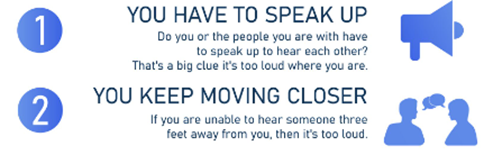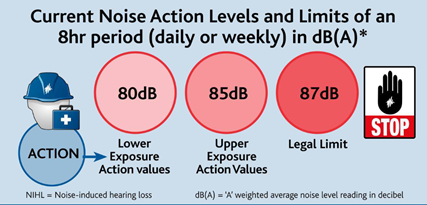The Impact of Excessive Noise in the Workplace
In the workplace, noise can pose a safety risk, and prolonged exposure to loud noises can result in irreversible hearing loss, frequently without the worker being aware of it until it is too late. It can also lead to tinnitus (ringing in the ears) or deafness.
According to HSE, almost 2 million workers in the UK are subjected to excessive noise levels at work, with noise-induced hearing loss accounting for the second-most employers' liability insurance claims for occupational health. To safeguard their employees from hearing loss and costly claims, businesses must take proactive steps to decrease noise exposure.
Signs that indicate it may be too loud in the workplace


The difference between Noise-Induced Hearing Loss and Presbycusis
It’s important to understand the difference between Noise-Induced Hearing Loss and Presbycusis, a condition caused by ageing of the ears. Presbycusis is primarily brought on by a lifetime of noise exposure, which causes the loss of nerve hair cells in the Cochlea, the organ that detects sound. By the time adults reach the age of 75, Presbycusis, the most prevalent type of hearing loss worldwide, affects more than 50% of adults.
Noise-Induced Hearing Loss is the acceleration of that process, through exposure to high noise levels. Noise-Induced Hearing Loss occurs when noise waves over stimulate the hair cells in the ear canal leading to a narrower hearing frequency range, tinnitus (ringing in the ears) and even permanent deafness. Compensation claims for Noise-Induced Hearing Loss can be up to £70,000, which a large price to pay in comparison to implementing a simple strategy to detect and control exposure to high noise levels.
Even a minor case of tinnitus or hearing loss can cost between £3000 and £7000 to litigate; a moderate case would cost between £7000 and £19,000, and total deafness can cost up to £70,000 (Quittance Legal Services, 2019). Indirect expenses like court costs, lost productivity, downtime, and employee morale are not included in this.
Although there is a deadline for filing a claim (successful claims must be made within three years of the diagnosis), claims against businesses are routinely filed in the UK, and the defending organisation will be asked to admit or deny liability. Documentation proving the employer took reasonable efforts to reduce noise in the workplace to an appropriate and sufficient level will need to be provided if they choose to contest liability. Occupational health assessments are typically necessary for higher risk workers, however noise risk assessments using personal dosimetry are also a possibility.
Reducing noise in fields such as construction, factories, farming etc can be difficult, however there are noise reduction safety measures you can put in place to stay legally compliant with UK HSE Legislation (The Control of Noise at Work Regulations 2005)
Measures that help manage noise levels in the workplace
Find out what noise levels your employees are exposed to first, then evaluate the risk to their hearing. It is advised to conduct noise risk assessments every two years. However, you should repeat this each time you make a big change to the workplace, such as moving equipment around, adjusting business hours, or changing shift schedules.
Depending on the levels of noise exposure identified in the risk assessment, additional controls may be:
- Control the noise exposure by engineering it out, eg fitting a silencer
- Change the work pattern or the layout of the workplace - not just rely on hearing protectors
- Provide the quietest machinery that will do the job
- Issue hearing protection (a selection, so workers can choose a type that suits them)
- Initiate an occupational health programmed that identifies early signs of hearing loss.
- Provide training and information
- Consult workers and their representatives.
If you’re unsure of how to assess noise levels in your business and would like expert advice contact Brows Safety Services today! Get an independent assessment of the risk your business is currently retaining with a FREE 1 hour on-site or remote consultation.
Email: enquiries@browns-safety.com or brownssafety@gmail.com
If you would like to discuss your options over the phone, please call 07931211442